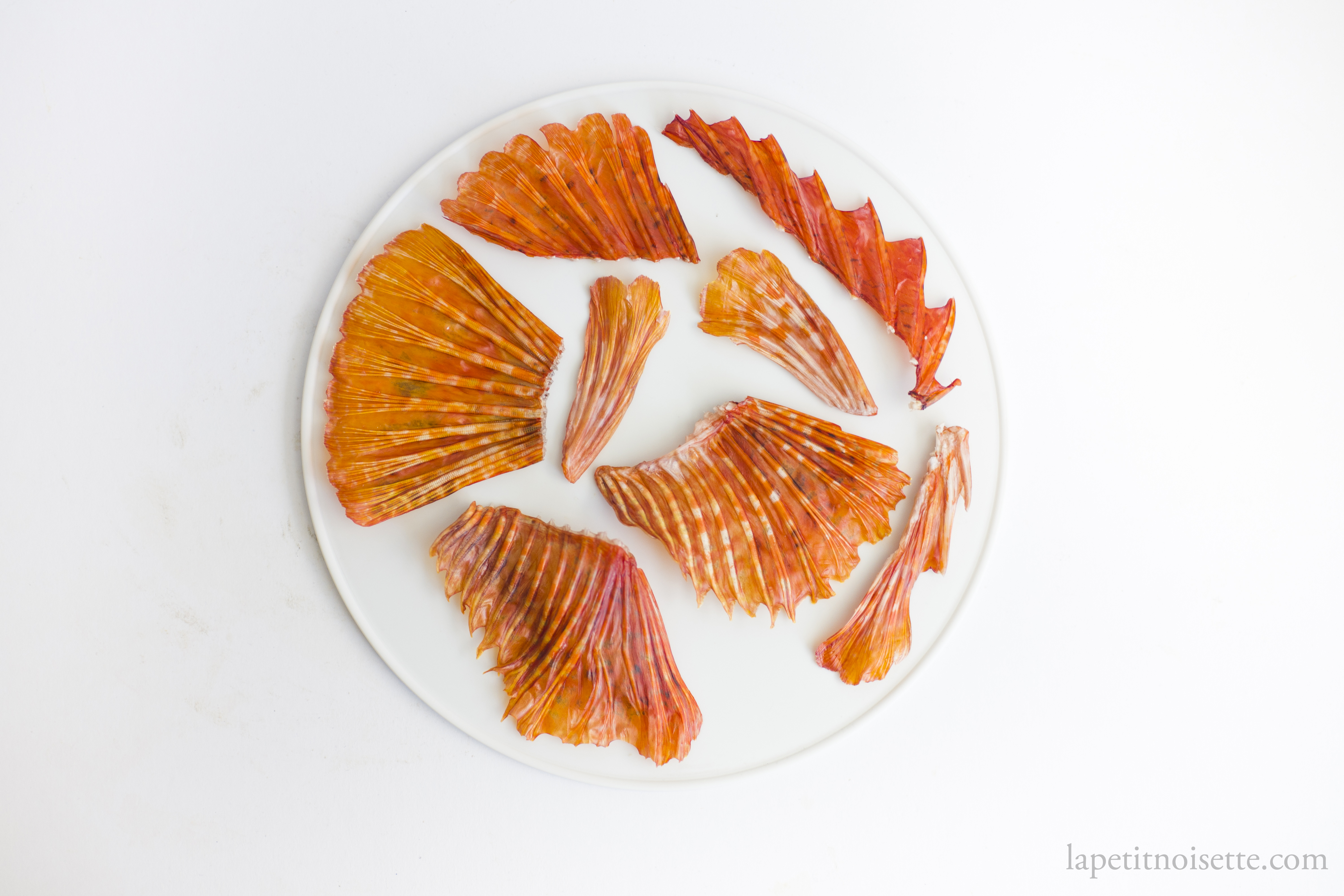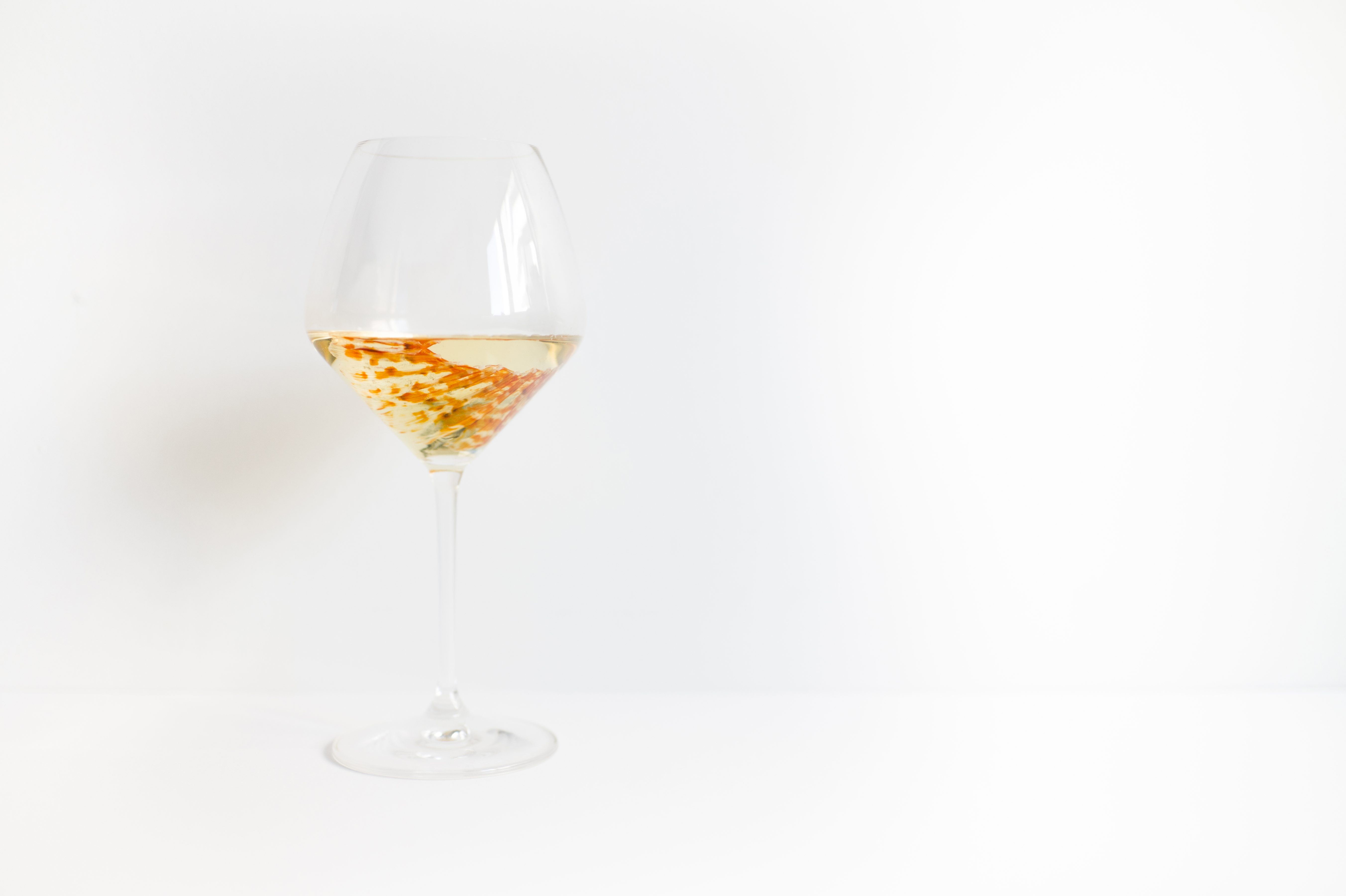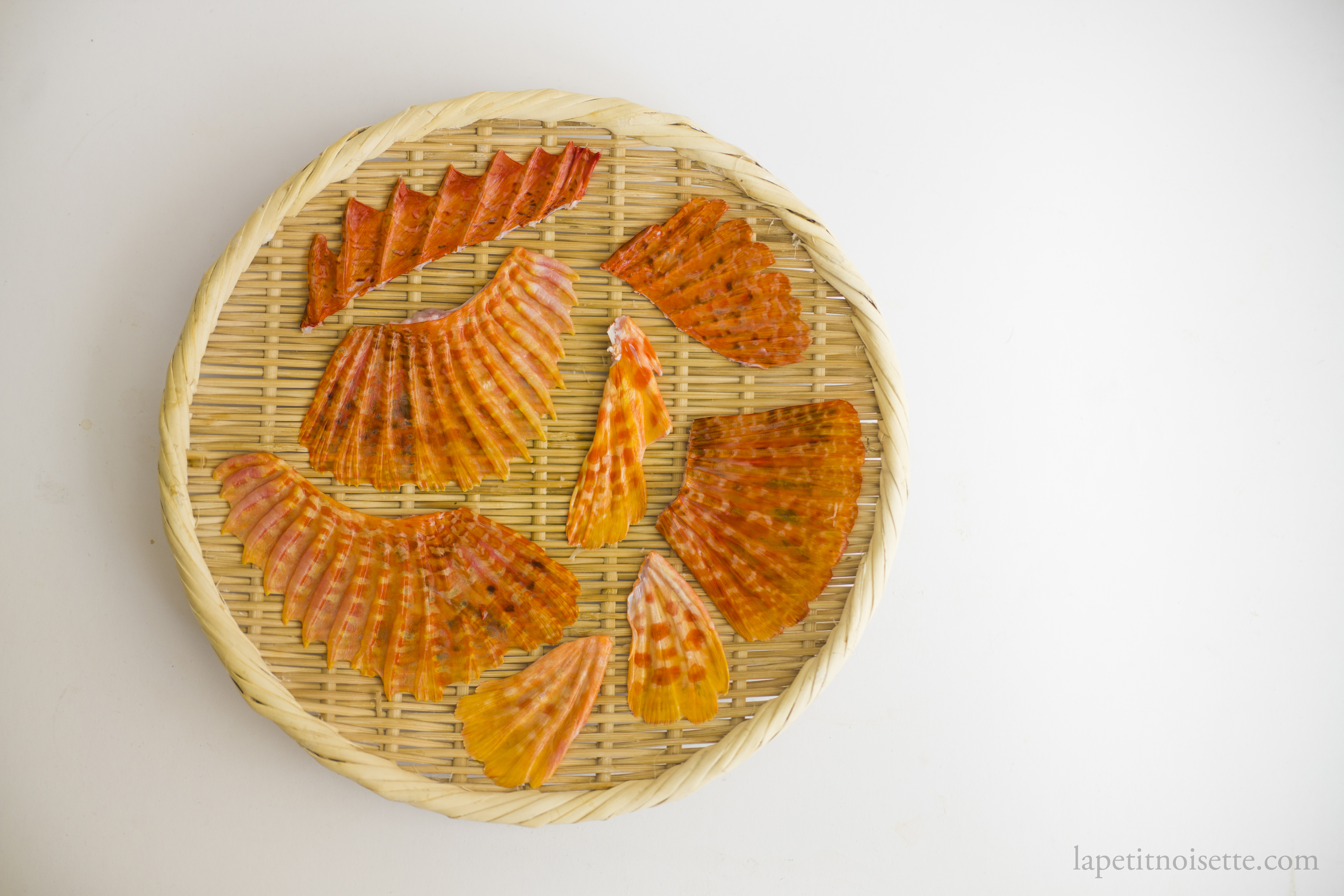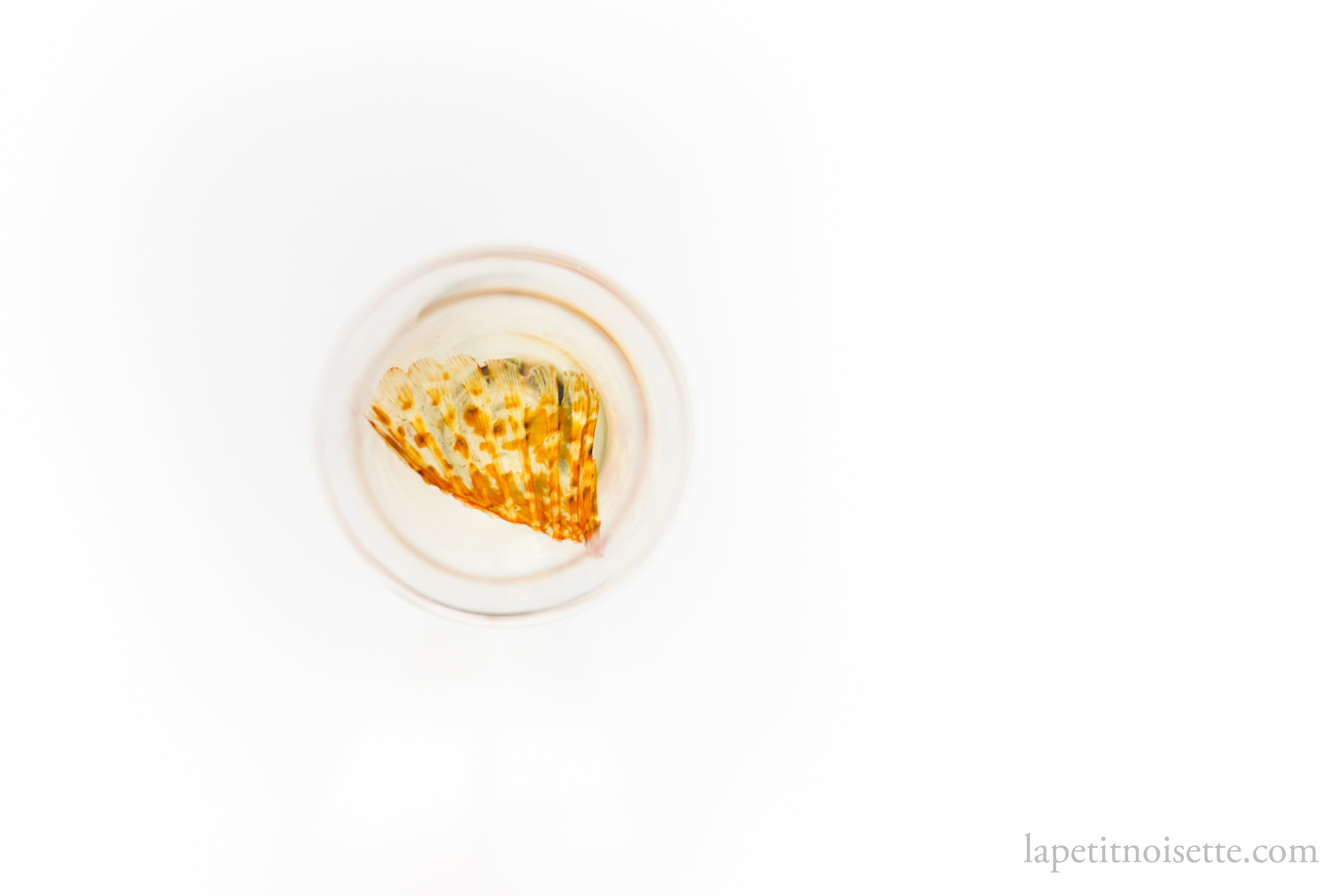*For a clarification between onikasago, izukasago and kasago please read our article.

Hirezake (ひれ酒) is a traditional Japanese digestif made by steeping fish fins in hot sake. It’s a drink you’d usually find at higher end establishments or in the homes of fishermen, and is getting less and less common to find. To prepare, the fins of fresh fish are dried for 2 or 3 days before being charred over charcoal. By steeping the fins in sake, the fins impart a richness to the sake, as well as a smokey nuttiness from the char. The resulting digestif is also not fishy unless the fins used were unfresh before being dried. Another similar version of this is Kotsuzake (骨酒), made by steeping roasted fish bones or whole fish in sake (which will be covered in another article).
Whilst various types of fish fins are used in the preparation of Hirezake, the most famous and sought after version of this drink is made from tiger pufferfish fins (とらふぐ). However, there does exist another fish that is said to equal or surpass that of tiger pufferfish, which is the fin of the demon scorpionfish, otherwise known as Onikasago or Izukasago (オニカサゴ/Scorpaena neglecta). It’s possible that Onikasago hirezake is even more rare compared to tiger pufferfish just because it’s not a fish commonly seen on the market but is instead caught by fishing enthusiasts.
Therefore, it’s almost impossible to find at a restaurant as you’d most likely find it at a fisherman’s dinner table. Onikasago is part of the Scorpaenidae family which contains all of the world’s venomous scorpionfish, lionfish and rockfish. Because of this, it’s often confused with the common Kasago. You can find more information on differentiating the two here. There always seemed to be something enticing about making liquors from venom, whether that be from pufferfish fins or that from Japanese giant hornets (Vespa mandarinia japonica/大雀蜂/スズメバチ) and onikasago hirezake is no different. Care must be taken when filleting onikasago as pricking your skin on their poisonous barbs can cause swelling and pain for a few hours, which is why their fins are usually cut off before filleting.

Outside of Japan, this recipe is actually more friendly for making at home compared to other types of hirezake because it can be made just as well with any fish in the Scorpaena genus which includes many scorpionfish already eaten in other countries. I’ve personally seen suitable scorpionfish in France, Italy, Greece and Australia.
When I first tried this drink, I was initially expecting a more savoury version of sake with a bit of smokiness from the toasting. However, whilst I was drying the fins, I noticed that their fishy smell faded as they dried as a very very faint spicy tinge emerged from the fins. It was very hard to detect but was strongest on the two pectoral fins. This got me excited for what the hirezake might turn out to taste like, but nothing prepared me for what it tasted like. After infusing the fins for 5 minutes and burning off the excess alcohol, I was blown away by how similar the sake smelled to the now infamous chinese shark fin soup! Whilst this was completely unexpected, it made sense in terms of explaining why this drink was so highly valued and after all, it was a drink made from fins. It was also far more savoury than what I expected. Having a taste that is associated with chinese cuisine so much, I think this drink would pair well with mapo tofu or even fish poached in chilli oil.
When choosing sake to make this dish, the key temperature to bear in mind is 80℃, as this is the temperature optimal for extracting desirable flavours from the fin. Any lower and the hirezake can be a little fishy. There actually exists a whole category of sake that is designed to be served warm, known as kanzake (燗酒). Kanzake varies in terms of temperature they’re supposed to be served at which are:
Hot (熱)
55~60℃ 飛び切り燗(tobikirikan/とびきりかん)
50℃ 熱燗(atsukan/あつかん)
45℃ 上燗(jyokan/じょうかん)
Warm (温)
40℃ ぬる燗(nurukan/ぬるかん)
35℃ 人肌燗(hitohadakan/ひとはだかん)
30℃ 日向燗(hinadakan/ひなたかん)

What you’d instantly notice here, is that the highest category of serving warm sake here is 60℃ which is much lower than the required 80℃. This is because alcohol (or ethanol specifically) evaporates at 78 °C and you’d typically not want to evaporate all the alcohol before you drink it, so this recipe isn’t strictly in the range of warmed sake. However, I’d always recommend using a high quality Kanzake over any expensive sake designed to be served cold as it’ll still be able to better stand up to being heated. In Japan, they heat up their sake using a machine known as a shukanki (酒燗器酒), but just heating your sake up over the stove until it reaches the desired temperature on a thermometer, or until small bubbles appear at the bottom of the pan works as well. If you dare you could even try using a sous vide machine to warm your sake, but in a bag or vessel of course, not directly into the machine.

Scorpionfish Hirezake Recipe (オニカサゴひれ酒の作り方)
Similarly, to make sake infused with puffer fish fin, you’d typically want to to toast the fins over charcoal or a flame until well toasted before infusing it in warm sake. The toasting method for both fins is the same, it is just that the fresher fins have more moisture in them. The key point to focus on when toasting the fins here is evenness. The base of the fins are thicker than the edge, and the edges of the fins are more likely to burn, just like when toasting frames for the akadashi miso soup recipe. You’d always want to focus on a slow toast for a deeper flavour rather than toasting the fin quickly. Before drying the fins, it’s crucial to remove any sliminess from the fins as it contributes a fishy taste to the hirezake. This recipe uses fresh izukasago fins from the filleting process here.
- 1 to 2 fins for 180ml of sake (for a large fish around 1kg and above, 1 pectoral fin per 180ml of sake will do)
- Submerge the fins with water and scrub/scrape off any slime from the fins using a sponge or the back of a spoon. Be careful not to prick yourself on the fins. If the slime is very hard to remove, wash with salt water.
- Lay out the fins in a single layer on a tray or drying rack under the sun for 2 to 3 days until fully dried. Cover with muslin cloth if you live in an area with flies.
- Toast the fins for 2 to 3 minutes on each side over a charcoal grill or open flame until well browned but not burnt. If you accidentally burn the tips of the fins, snip off with a pair of scissors.
- Heat the sake to 80℃ and add the toasted fins into the sake.
- Place a lid over the cup of sake and allow it to steep for 3 to 5 minutes. If your cup has no lid, simply use a piece of aluminium foil.
- As done in restaurants, serve with the lid on the sake, and upon opening, light the alcohol fumes with a match/lighter.